Abstract
To improve the efficacy of plasminogen activators, we produced a monoclonal antibody (RWR) that inhibits human alpha 2-antiplasmin (alpha 2AP). In addition to inhibiting alpha 2AP in plasma, RWR binds to and inhibits fibrin cross-linked alpha 2AP and reproduces the "spontaneous" clot lysis that is the hallmark of human alpha 2AP deficiency. By inhibiting the inactivation of plasmin by alpha 2AP, RWR interacts synergistically with plasminogen activators to increase the potency (for 50% clot lysis) of urokinase by 80-fold, tissue plasminogen activator by 27-fold, and streptokinase by 20-fold. Yet, for a given amount of fibrinolysis, the combination of RWR and lower doses of plasminogen activator leads to less fibrinogen consumption than is obtained with higher, equipotent doses of plasminogen activator alone. These results suggest a strategy for increasing the efficacy of plasminogen activators. More generally, this approach to amplifying enzymatic activity by immunoneutralizing an inhibitor may be useful in other biologic processes that are rigidly governed by inhibitors.
Full text
PDF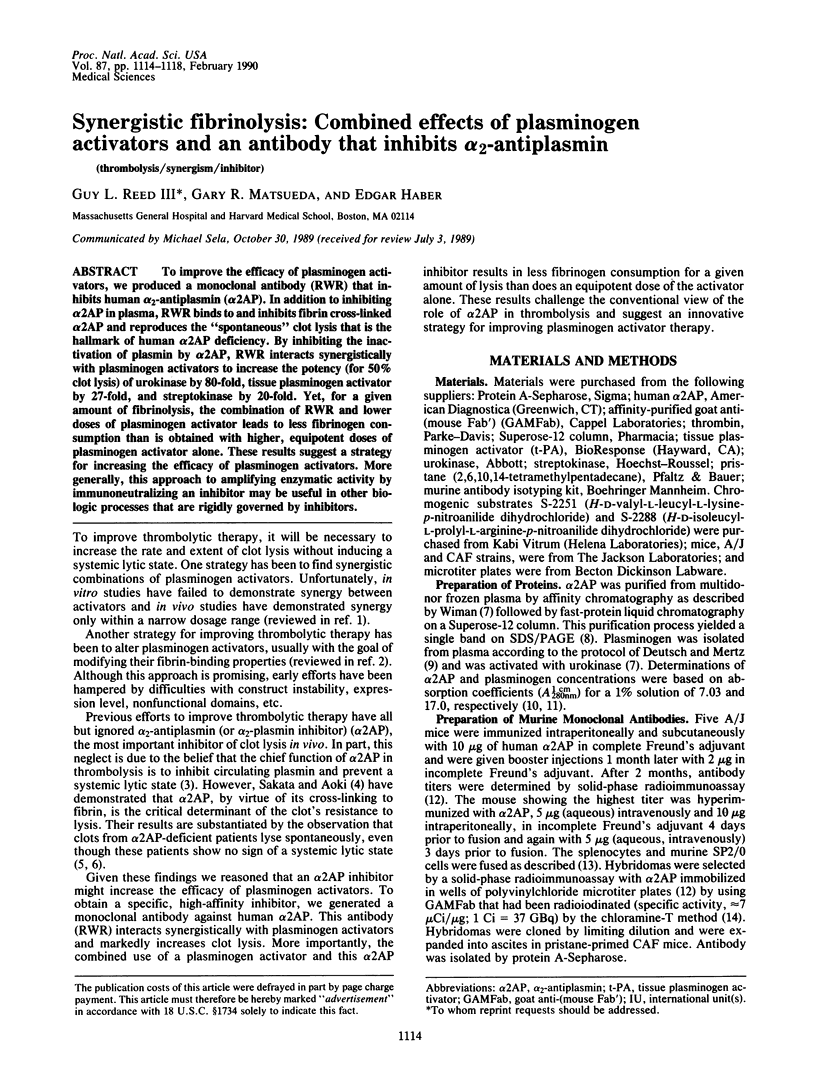
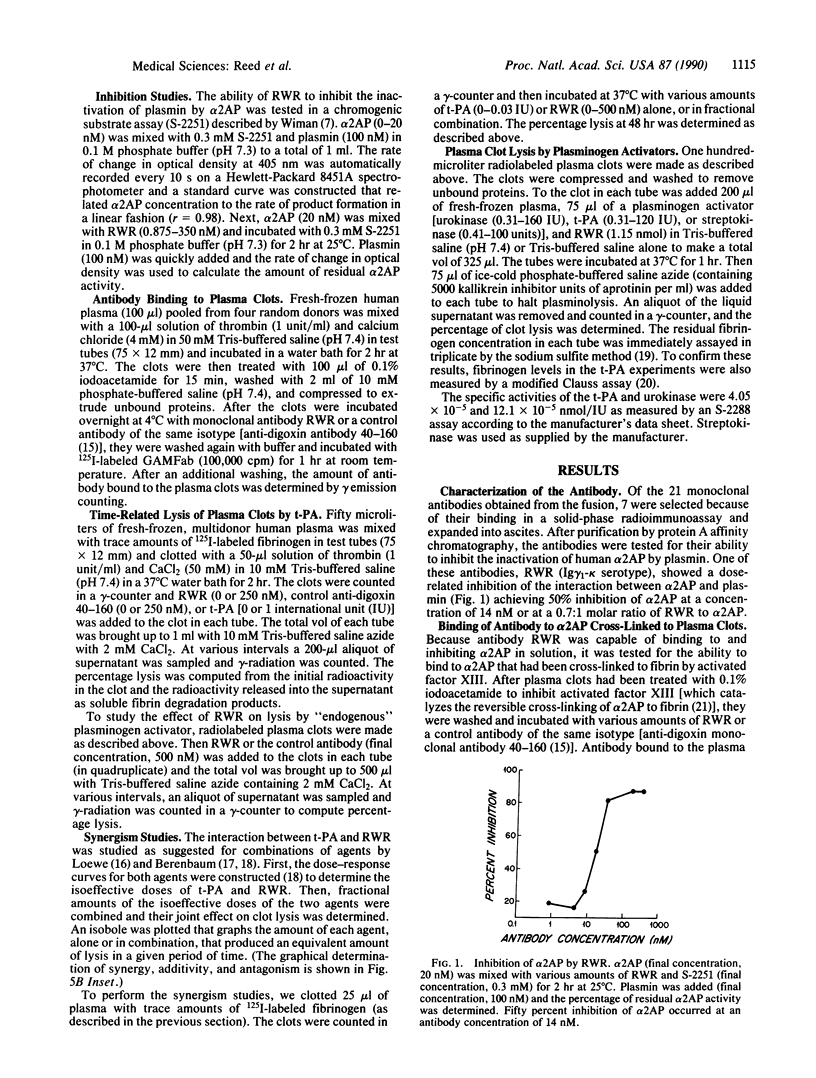
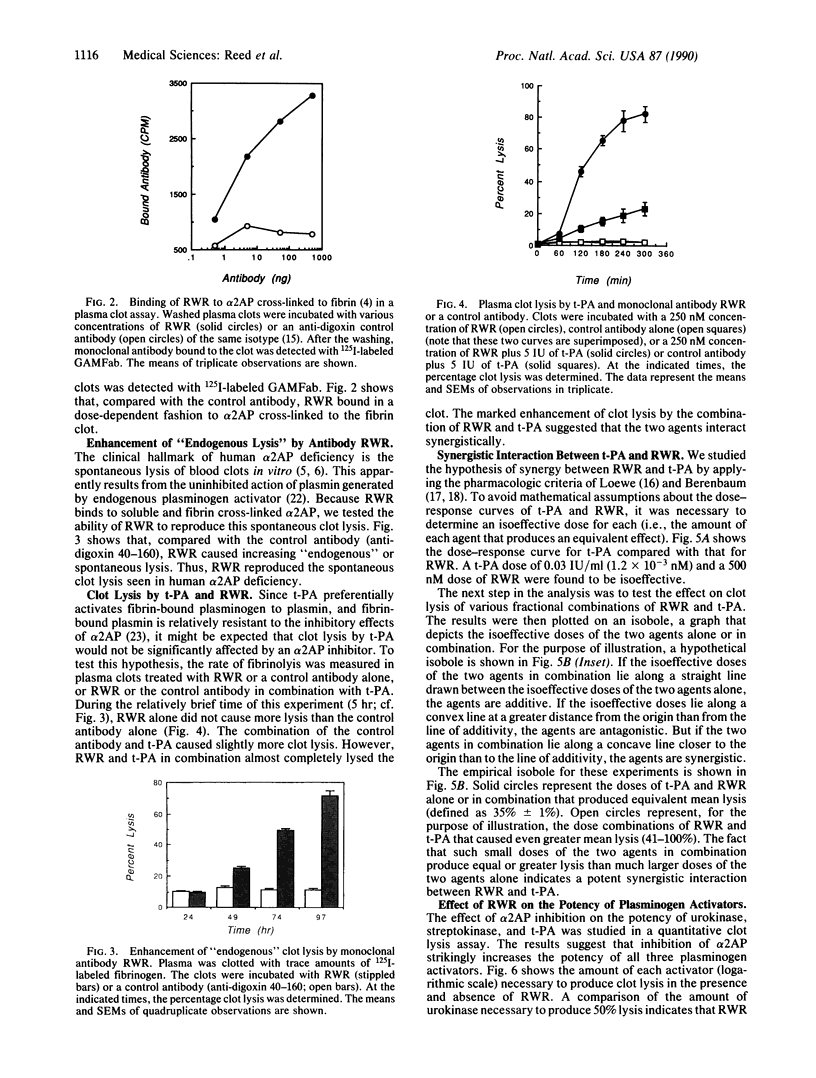
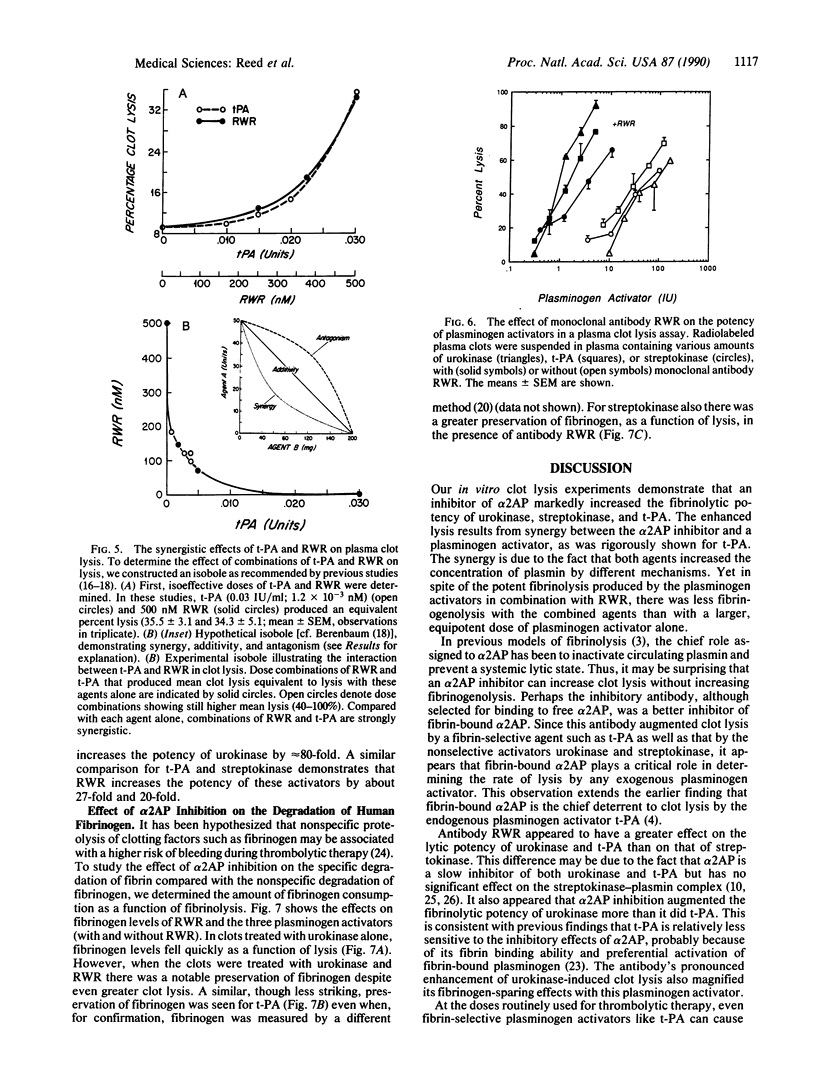
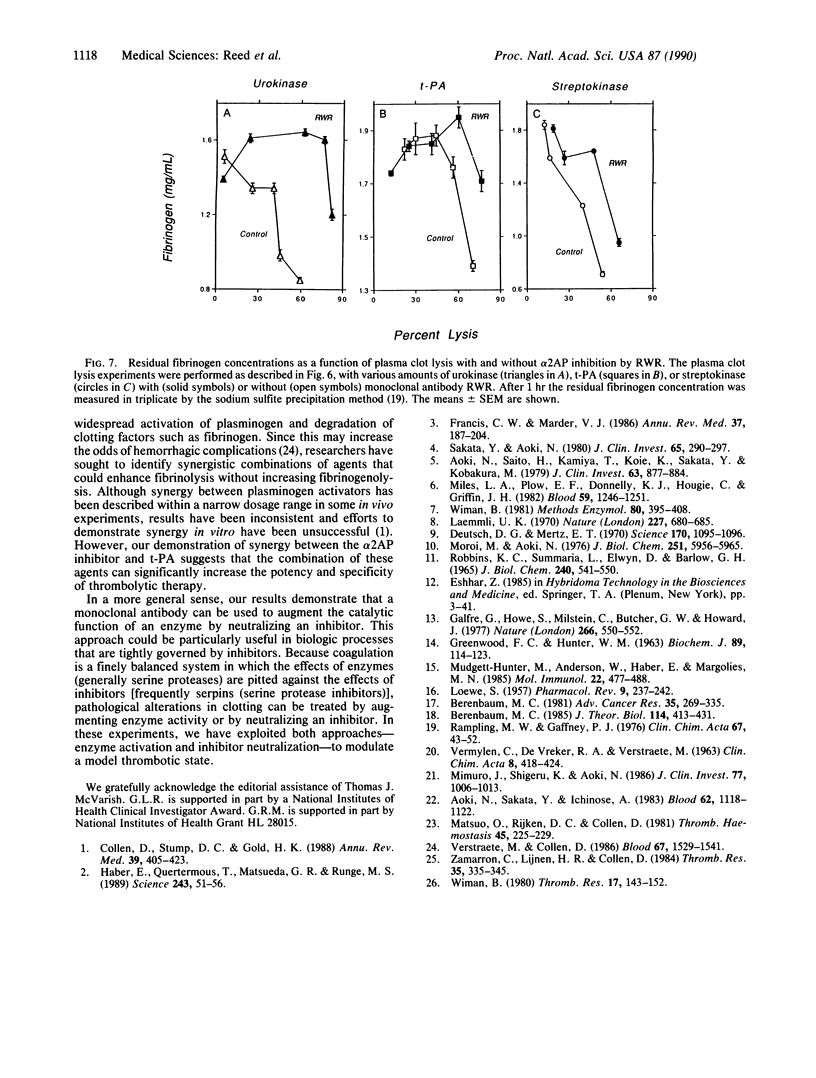
Images in this article
Selected References
These references are in PubMed. This may not be the complete list of references from this article.
- Aoki N., Saito H., Kamiya T., Koie K., Sakata Y., Kobakura M. Congenital deficiency of alpha 2-plasmin inhibitor associated with severe hemorrhagic tendency. J Clin Invest. 1979 May;63(5):877–884. doi: 10.1172/JCI109387. [DOI] [PMC free article] [PubMed] [Google Scholar]
- Aoki N., Sakata Y., Ichinose A. Fibrin-associated plasminogen activation in alpha 2-plasmin inhibitor deficiency. Blood. 1983 Nov;62(5):1118–1122. [PubMed] [Google Scholar]
- Berenbaum M. C. Criteria for analyzing interactions between biologically active agents. Adv Cancer Res. 1981;35:269–335. doi: 10.1016/s0065-230x(08)60912-4. [DOI] [PubMed] [Google Scholar]
- Berenbaum M. C. The expected effect of a combination of agents: the general solution. J Theor Biol. 1985 Jun 7;114(3):413–431. doi: 10.1016/s0022-5193(85)80176-4. [DOI] [PubMed] [Google Scholar]
- Collen D., Stump D. C., Gold H. K. Thrombolytic therapy. Annu Rev Med. 1988;39:405–423. doi: 10.1146/annurev.me.39.020188.002201. [DOI] [PubMed] [Google Scholar]
- Deutsch D. G., Mertz E. T. Plasminogen: purification from human plasma by affinity chromatography. Science. 1970 Dec 4;170(3962):1095–1096. doi: 10.1126/science.170.3962.1095. [DOI] [PubMed] [Google Scholar]
- Francis C. W., Marder V. J. Concepts of clot lysis. Annu Rev Med. 1986;37:187–204. doi: 10.1146/annurev.me.37.020186.001155. [DOI] [PubMed] [Google Scholar]
- GREENWOOD F. C., HUNTER W. M., GLOVER J. S. THE PREPARATION OF I-131-LABELLED HUMAN GROWTH HORMONE OF HIGH SPECIFIC RADIOACTIVITY. Biochem J. 1963 Oct;89:114–123. doi: 10.1042/bj0890114. [DOI] [PMC free article] [PubMed] [Google Scholar]
- Galfre G., Howe S. C., Milstein C., Butcher G. W., Howard J. C. Antibodies to major histocompatibility antigens produced by hybrid cell lines. Nature. 1977 Apr 7;266(5602):550–552. doi: 10.1038/266550a0. [DOI] [PubMed] [Google Scholar]
- Haber E., Quertermous T., Matsueda G. R., Runge M. S. Innovative approaches to plasminogen activator therapy. Science. 1989 Jan 6;243(4887):51–56. doi: 10.1126/science.2492113. [DOI] [PubMed] [Google Scholar]
- LOEWE S. Antagonisms and antagonists. Pharmacol Rev. 1957 Jun;9(2):237–242. [PubMed] [Google Scholar]
- Laemmli U. K. Cleavage of structural proteins during the assembly of the head of bacteriophage T4. Nature. 1970 Aug 15;227(5259):680–685. doi: 10.1038/227680a0. [DOI] [PubMed] [Google Scholar]
- Matsuo O., Rijken D. C., Collen D. Comparison of the relative fibrinogenolytic, fibrinolytic and thrombolytic properties of tissue plasminogen activator and urokinase in vitro. Thromb Haemost. 1981 Jun 30;45(3):225–229. [PubMed] [Google Scholar]
- Miles L. A., Plow E. F., Donnelly K. J., Hougie C., Griffin J. H. A bleeding disorder due to deficiency of alpha 2-antiplasmin. Blood. 1982 Jun;59(6):1246–1251. [PubMed] [Google Scholar]
- Mimuro J., Kimura S., Aoki N. Release of alpha 2-plasmin inhibitor from plasma fibrin clots by activated coagulation factor XIII. Its effect on fibrinolysis. J Clin Invest. 1986 Mar;77(3):1006–1013. doi: 10.1172/JCI112352. [DOI] [PMC free article] [PubMed] [Google Scholar]
- Moroi M., Aoki N. Isolation and characterization of alpha2-plasmin inhibitor from human plasma. A novel proteinase inhibitor which inhibits activator-induced clot lysis. J Biol Chem. 1976 Oct 10;251(19):5956–5965. [PubMed] [Google Scholar]
- Mudgett-Hunter M., Anderson W., Haber E., Margolies M. N. Binding and structural diversity among high-affinity monoclonal anti-digoxin antibodies. Mol Immunol. 1985 Apr;22(4):477–488. doi: 10.1016/0161-5890(85)90132-4. [DOI] [PubMed] [Google Scholar]
- ROBBINS K. C., SUMMARIA L., ELWYN D., BARLOW G. H. FURTHER STUDIES ON THE PURIFICATION AND CHARACTERIZATION OF HUMAN PLASMINOGEN AND PLASMIN. J Biol Chem. 1965 Jan;240:541–550. [PubMed] [Google Scholar]
- Rampling M. W., Gaffney P. J. The sulphite precipitation method for fibrinogen measurement; its use on small samples in the presence of fibrinogen degradation products. Clin Chim Acta. 1976 Feb 16;67(1):43–52. doi: 10.1016/0009-8981(76)90215-1. [DOI] [PubMed] [Google Scholar]
- Sakata Y., Aoki N. Cross-linking of alpha 2-plasmin inhibitor to fibrin by fibrin-stabilizing factor. J Clin Invest. 1980 Feb;65(2):290–297. doi: 10.1172/JCI109671. [DOI] [PMC free article] [PubMed] [Google Scholar]
- VERMYLEN C., DE VREKER R. A., VERSTRAETE M. A rapid enzymatic method for assay of fibrinogen fibrin polymerization time (FPT test). Clin Chim Acta. 1963 May;8:418–424. doi: 10.1016/0009-8981(63)90080-9. [DOI] [PubMed] [Google Scholar]
- Verstraete M., Collen D. Thrombolytic therapy in the eighties. Blood. 1986 Jun;67(6):1529–1541. [PubMed] [Google Scholar]
- Wiman B. On the reaction of plasmin or plasmin-streptokinase complex with aprotinin or alpha 2-antiplasmin. Thromb Res. 1980 Jan 1;17(1-2):143–152. doi: 10.1016/0049-3848(80)90302-3. [DOI] [PubMed] [Google Scholar]
- Zamarron C., Lijnen H. R., Collen D. Influence of exogenous and endogenous tissue-type plasminogen activator on the lysability of clots in a plasma milieu in vitro. Thromb Res. 1984 Aug 1;35(3):335–345. doi: 10.1016/0049-3848(84)90364-5. [DOI] [PubMed] [Google Scholar]



